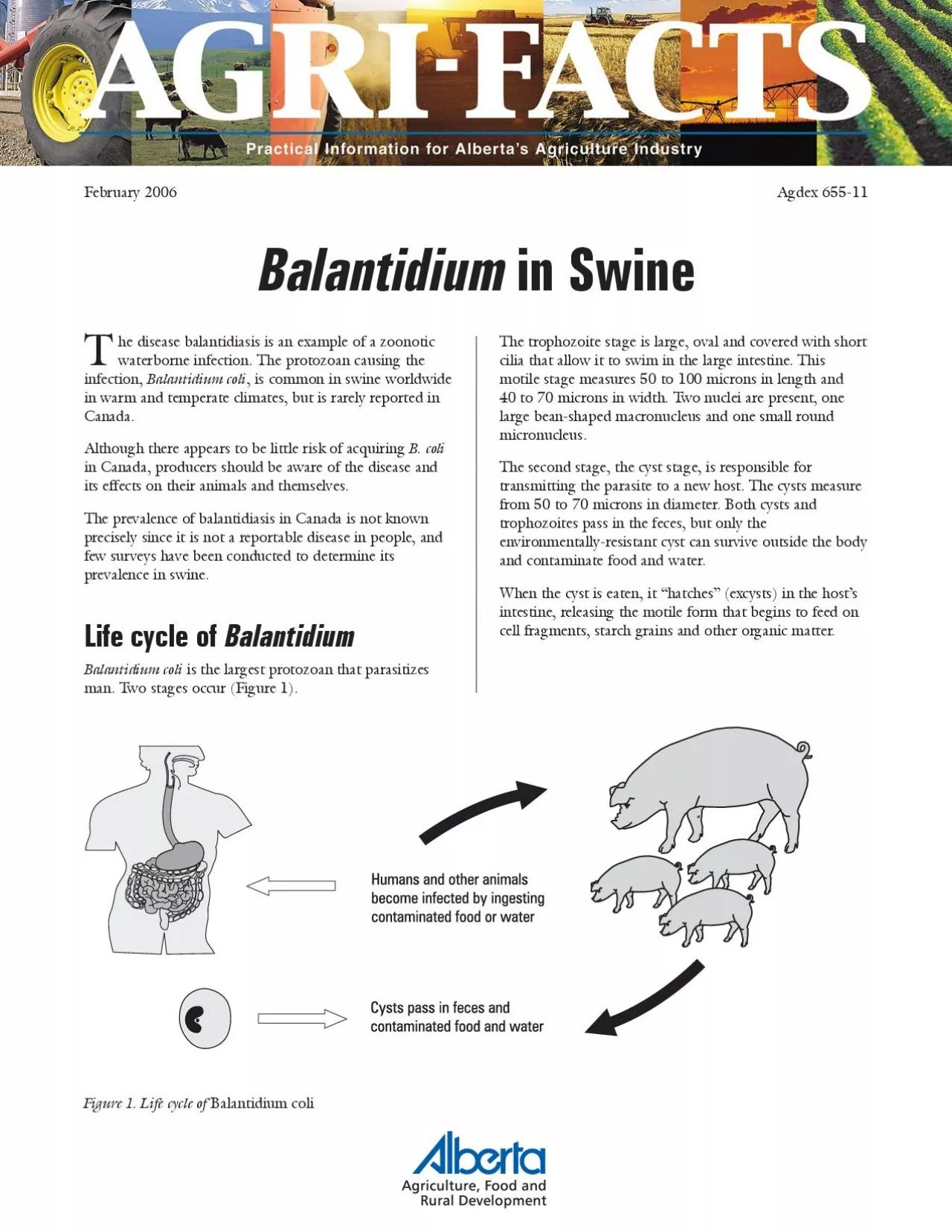

February 2006 in Swine 2 harm is usually found as a harmless organism inpigs but it can sometimes cause severe clinical and even can be found in all age categories ofSome pigs experience moderate t ID: 937243
Download Pdf The PPT/PDF document "waterborne infection The protozoan causi..." is the property of its rightful owner. Permission is granted to download and print the materials on this web site for personal, non-commercial use only, and to display it on your personal computer provided you do not modify the materials and that you retain all copyright notices contained in the materials. By downloading content from our website, you accept the terms of this agreement.
February 2006 in Swine waterborne infection. The protozoan causing thein warm and temperate climates, but is rarely reported inAlthough there appears to be little risk of acquiring in Canada, producers should be aware of the disease andThe prevalence of balantidiasis in Canada is not knownprecisely since it is not a reportable disease in people, andprevalence in swine. is the largest protozoan that parasitizesman. Two stages occur (Figure 1).Figure 1. Life cycle of The trophozoite stage is large, oval and covered with shortcilia that allow it to swim in the large intestine. Thismotile stage measures 50 to 100 microns in length and40 to 70 microns in width. Two nuclei are present, onelarge bean-shaped macronucleus and one small roundThe second stage, the cyst stage, is responsible fortransmitting the parasite to a new host. The cysts measurefrom 50 to 70 microns in diameter. Both cysts andtrophozoites pass in the feces, but only theenvironmentally-resistant cyst can survive outside the bodyand contaminate food and water.When the cyst is eaten, it hatches (excysts) in the hostsintestine, releasing the motile form that begins to feed oncell fragments, starch grains and other organic matter. 2 harm is usually found as a harmless organism inpigs, but it can sometimes cause severe clinical and even can be found in all age categories ofSome pigs experience moderate to severe diarrhoea, whileothers show no sign of disease. The difference between theacute and the symptomless pigs may indicate that differentstrains of the parasite are involved. Sows can shed manycysts thereby contaminating farrowing pens. from pigs and humansare the same species. However, some pig strains of theparasite can be distinguished from human strains and areYour veterinarian can do a r
outine microscopicexamination of a fresh fecal sample to find the organism.Cysts are found in normal feces whereas trophozoites are have been described from pigs, from guinea pigs andfrom frogs. Pigs appear to be the majorreservoir of strains of found in humans. harm people? in pigs is identical to thespecies known from humans, and that is why theirimportance in the study of disease and prevention is notclear. Humans are apparently not susceptible to some pig produce no sign of infection,while other strains may cause severe diarrhoea. As in pigs,the differences in clinical features may be the result ofdifferences in host susceptibility to the parasite ordifferences in the virulence of particular strains of thedevelop diarrhoea, nausea, vomiting, anorexia andheadache. Recurrent diarrhoea may persist for weeks to rarely invades the intestine. When it does, itproduces ulceration of the colon. Some of the ulcers mayoccur.How is infection spread?People become infected when they accidentally ingest cystscontaminating food or water. Domestic hogs probablyserve as the most important reservoir host for humanIn areas where pigs are the main domestic animal, theprevalence of human infection can be high. Pig farmers,butchers or people working in slaughterhouses areHuman infection is fairly rare in temperate areas, althoughonce the infection is established, it can spread to others,particularly where poor environmental sanitation andpersonal hygiene are found.Overcrowded pens or barns and poor sanitation practicesare some of the factors that can lead to the spread ofingesting infective cysts in contaminated food and water,preventative measures involve increased attention topersonal hygiene and sanitation measures.Prepared by:Murray J. Kennedy, Ph.D.Food Safety Divisio